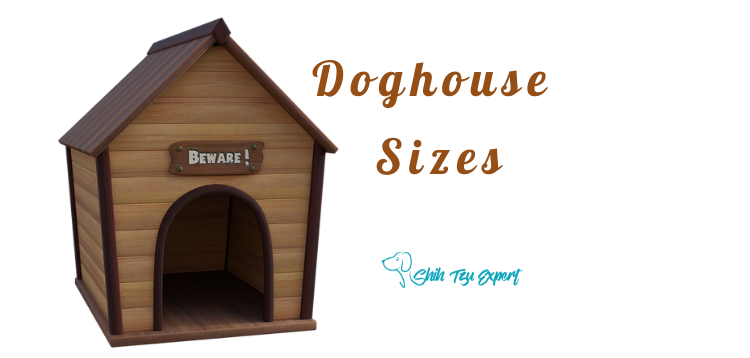 If you own a dog, chances are you are a dog-lover and want nothing but the very best for your animal. Maybe that means letting him or her lounge on the couch, sleep in your bed, and/or sneaking a taste of the leftovers from dinner.
If you own a dog, chances are you are a dog-lover and want nothing but the very best for your animal. Maybe that means letting him or her lounge on the couch, sleep in your bed, and/or sneaking a taste of the leftovers from dinner.
For some dog-owners, providing for their pets also means investing in dog houses. Dog houses give dogs the ability to relax, nap, and chill out in a quiet, cozy place that is completely their own.
Dogs are highly social beings and love being with their humans. However, dogs also love spending time outside. A doghouse can be a great place for your pup to chill when spending time outside, while also acting as shelter.

Designing a Doghouse: Methods, Kinds, and Styles
When investing in a doghouse, the first step is to determine if you wish to build one yourself or purchase one from any kennel companies, such as Chewy. Either one will provide an adequate doghouse.
Building a doghouse yourself can be a cost-effective method, especially if you already own the primary tools required, such as a hammer, nails, and tape-measurer. You may just need to purchase the material you choose to build with, which you can find at any local hardware store.
However, building a house comes with a more significant time-commitment than purchasing one.
Ordering a doghouse from a company will deliver right to your door, and minimal assembly may be required.
How to Get Started: Building it Yourself
Step One: Choose the Material
The most common materials for dog houses are wood, plastic, and metals. There are also pros and cons to each of these that you may want to consider.
Wood is a highly practical and popular option for dog houses. Since wood is inexpensive and easy to work with, wood allows dog owners to create a functional and aesthetically pleasing masterpiece right in the backyard. Plus, wood is an excellent insulator to regulate the temperature of your dog’s home.
Plastic is most commonly seen used in dog houses that are manufactured by companies for purchase. If you decide to buy a doghouse instead, plastic can be a good choice, as it is also inexpensive and you don’t have to worry about molding or rotting.
However, plastic is not the most recommended choice of material because it has no temperature regulation capabilities, resulting in uncomfortable conditions during hot and cold months.
Step 2: Obtain Accurate Measurements
This step is crucial, as it determines the size of your doghouse. If the house is too small, your dog may not be able to comfortably lay down or sit up. Conversely, if the house is too roomy, it will lose its coziness and temperature regulation.
More specific information, guidelines and standard measurements will be discussed further later in this article.
Step 3: Style
A final component determining the style of the doghouse.
There are multiple styles of dog houses that are used among dog-owners and companies, ranging from human house look-alikes, to those with removable roofs, to those with attached patios.
The different styles that will be outlined below vary according to function and level of aesthetic.
Wood: If you decide to go with wood as the material, there are three popular styles of houses. The most common is the pitched roof style. This style looks the most like a human house, in that the roof is in the shape of a triangle. This style is straightforward to build and is also one of the most common styles to purchase.
A second style wood house is the single panel flat roof house. This style can be described as a simple fort-like structure that has a removable roof to give your dog ample access to sunshine and the breeze but can also protect your dog from harsher elements.
Finally, if you really want to get creative, you can design a loft style house for your dog. This may be the most realistic for smaller dogs, but you can create a house with two -floors so your dog has the flexibility to move throughout their home (complete with stairs!)
Plastic and Metal: since you will most likely purchase houses made of plastic, you can choose a style house that you prefer without worrying about the logistics of the construction. Companies manufacture a variety of styles made of plastic, such as those described above. The only factor to keep in mind is the complexity of assembly on your part.
Additional Tips:
All of these depend on financial and time commitment you’d like to invest, as well as importance to you.
Additional Style Tips
Generally speaking, you can also design a house that has a specific door shape and size. However, it is recommended to focus more on the functional aspect of the door, as this is how your dog will enter and exit the house, as well as determine how well-protected your dog is from weather.
You can also design a doghouse with a raised floor. Creating a raised floor can have functional benefits, such as preventing water damage.
Finally, one component of a doghouse that is often overlooked in terms of functionality versus aesthetics is bedding.
It is common for dog owners to want to fill their dog’s house with comfy materials to lay on, such as pillows, blankets, and sheets. However, these things are more likely to absorb water and also put the house at risk of attracting bugs and fleas.
Doghouse Dimensions: How to Measure Appropriately
As described at the beginning of this article, obtaining the appropriate measurements, regardless of whether you are building or buying, is essential is determining the right size house for your dog.
The reason for this is because your dog needs to be able to walk in and out, turn around, sit, and lay down comfortably, while also feeling content in a secure, comfortable environment. You want to avoid committing to a house that is neither too big nor too small.
To determine the appropriate size and dimensions of the doghouse, you want to collect 3 primary measurements of your dog:
- the length of your dog, which is from the tip of the nose to the buttocks (excluding the tail) laying down
- the width of your dog, which is the distance between the shoulders
- and the height, which is best measured from the top of the dog’s head to the ground. Some formulas recommend measuring height from the dog’s shoulder to the ground. How you choose to measure depends on how snug you want to house to be.
Once you have these measurements, there are several recommended formulas that you can use to determine the measurements of your house. You don’t want to build a house that is the exact size of your dog because they will have no wiggle room.

Formulas
However, many formulas are confusing, so some of the most basic formulas are described below:
- HOUSE LENGTH = Dog length X 2
HOUSE WIDTH = Dog width X 3
HOUSE HEIGHT = Dog height X 2
DOORWAY = Dog height X 1
This formula is easy to follow and accounts for adding more space for your dog without making the house too big.
- DEPTH = Dog’s length X 3
LENGTH = Dog’s length X 3
HEIGHT = Dog’s height X 2
- Another formula, created by the Humane Society out of Asheville, North Carolina builds on the previous two formulas, but is catered specifically to medium sized dogs. formula is also used to create a specific style house, which entails a structure with varying heights. This formula also does not account for the size of a door.
LENGTH = Dog’s length + 12 inches
WIDTH = Dog’s length + 18 inches
LOW SIDE HEIGHT = Dog’s height + 3 inches
HIGH SIDE HEIGHT = Dog’s height + 9 inches
- Two veterinarians named Foster and Smith suggest that you trace a rectangle around your dog while your dog is laying down, measure each side, and then add 3 inches to each dimension to generate enough room. They also suggest taking the height of your dog (to the shoulder) and adding 5 inches.
- One trick to use to determine the length of the house and the size of the opening is that the length should be slightly longer than your dog, and the opening be 75% of the dog’s shoulder height. The opening does not need to be the exact height of your dog because your dog can duck to enter and exit, and the smaller the opening, the better insulated the house will be.
- Finally, if you decide to purchase a doghouse, many companies provide sizing charts that you can use to determine which size to order. Some even offer size charts by breed. You can either go by the size listed by breed (if you feel that your dog is around the standard size of the breed), or you can still obtain the needed measurements and compare to the general size chart. It is recommended to obtain measurements of your dog anyway and compare them to the ones provided, just to cover your basis.
Standard Measurements (by Average Dog Size Groups)
If you’d like some idea about how big your doghouse should be, below are general dimensions based on average dog sizes.
For small dogs (25 pounds and under) the standard dimensions for a doghouse are:
24” in height X 24” in width.
The length should be slightly longer than your dog. For example, if your dog is 20 inches in length, the house length should be 22 to 25 inches long. This size group is most closely compatible with breeds such as chihuahuas and Maltese.
For medium sized dogs (between 25 and 50 pounds) the standard dimensions are approximately compatible with the dimensions of a small doghouse. To ensure optimal room, measure your dog and utilize one of the formulas described above. This size group is most compatible with breeds such as a beagle or terrier.
For large dogs (between 50 and 100 pounds) the dimensions are:
approximately 30” wide and 32” high.
The recommended length is approximately 36 inches based on the typical large dog, but you can measure your dog and add a few inches in case. This size group is most compatible with breeds such as retrievers and labs.
For XL dogs (100 pounds and up):
36 inches wide, 42 inches high, and approximately 42 inches long.
It is recommended to measure your dog to account for variation in standard size. It is recommended to use this sizing standard when building a house for breeds such as Saint Bernards and Great Danes.
TIP: while these are helpful starting points, it is still recommended to measure your dog specifically, as your dog may be smaller or larger than the typical population of the size group.
Things to Consider/ Additional Tips
There are a few other tips that for you to keep in mind regarding your dog’s new home.
Also, if you are concerned regarding how much your dog will use their house, one tip is that you can purchase a basic doghouse, and if your dog enjoys it and gets substantial use out of it, you can also add upgrades to it later on.
Same goes for if you are feeling inspired to build your own. You can always build a basic one, and then create additions later.
In addition, you can adjust the dimensions of the house based on where you live. While you still need to ensure that the house is big enough for the dog to move about slightly, you can adjust the size to fit the weather conditions. If you live in a warmer climate, you can make the house slightly larger to allow for more of a draft and air to circulate to keep your dog cooler. If you live in a colder climate, you can make the house slightly smaller to allow for heat to stay in better.
It is also recommended to refrain from introducing a doghouse to an older dog. Puppies are easier to condition to use the doghouse while they are being trained.
Conclusion
Whatever you decide, you are investing in a project that will bring joy and comfort to your furriest family member.


![Best Cheap Dog Foods - our Top 10 Picks of High Quality Brands That Are Still Affordable [Under $1 per pound!] in 2023 Best Cheap Dog Foods - our Top 10 Picks of High Quality Brands That Are Still Affordable [Under $1 per pound!] in 2023](https://shihtzuexpert.com/wp-content/uploads/2018/01/Best-Cheap-Dog-Food-Featured-image.png)


